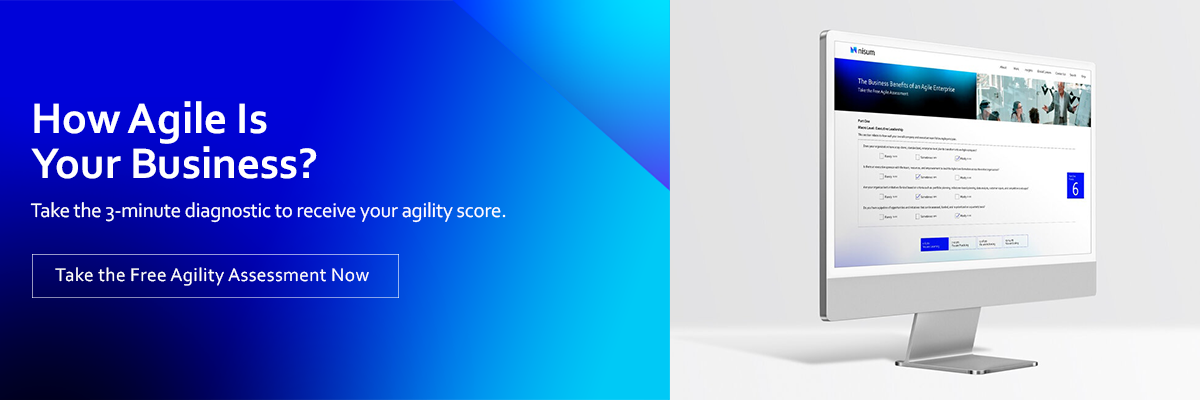 Source: iStock
Source: iStock
Business leaders of many Fortune 500 companies had to broaden their delivery models to adapt to the changes caused by COVID-19. They needed to quickly figure out new ways to get work done in the immediate term to reconsider how they could continue delivering projects on time during the pandemic. Some companies were in a better position to respond quickly and developed new ways to work. These new learnings can bring big changes in the way companies approach projects because they reduce costs significantly and allow teams to scale quickly by leveraging locations where they can find the right talent to process the projects faster with quality.
 Nisum SVP of Growth and Delivery, Prashant Sharma, partnered closely with Fortune 100 companies to tackle these unexpected changes and supported them to address the uncertainty surrounding the state of delivery models during the pandemic. Varun Goyal of the Go-to-Market team sat down with Prashant to hear how he believes COVID-19 has changed service delivery models. Here are some key takeaways from their conversation.
Nisum SVP of Growth and Delivery, Prashant Sharma, partnered closely with Fortune 100 companies to tackle these unexpected changes and supported them to address the uncertainty surrounding the state of delivery models during the pandemic. Varun Goyal of the Go-to-Market team sat down with Prashant to hear how he believes COVID-19 has changed service delivery models. Here are some key takeaways from their conversation.
Varun: How were projects traditionally delivered before COVID-19?
Prashant: Prior to the pandemic, it was standard practice for big companies to bolster up their teams with offshore resources to reduce costs and scale quickly.To ensure the process ran smoothly and projects were delivered on time with quality, three roles were traditionally required to be onsite to facilitate direct client interaction. Those roles were a product manager, who works with the client’s business group, a program manager, who oversees the project with regard to the resources, time, and budget, and a technical lead/architect, who designs the structure of new tech systems and oversees the implementation of programs while liaising with the software development teams offshore.
Varun: How did the delivery team’s structure get affected by COVID-19?
Prashant: Due to COVID-19’s safer-at-home restrictions, most people no longer work on location and now participate in a distributed workforce. Many companies were forced to change their delivery models to adapt to this change. These three key roles were no longer able to be together onsite to interface with clients so more importance was put on a well-defined scope of work. We found that if the project’s needs are well-defined, it would not require a technical lead/architect to be onsite because the defined scope would allow them to work from offsite or even offshore. Even if the project needed definition, companies could have a product manager define it with the client; but then, only one role would be required to be onsite.
Varun: Going forward, how can companies leverage this new delivery model?
Prashant: The unexpected shift in work culture could potentially change the way delivery models are defined and executed as it opens up more opportunities to move key positions offshore. If the teams have the proper skillset and scope planning, projects can be delivered from any part of the world without affecting the quality nor the agreed-upon timelines. With the cost savings from moving resources offshore, companies can afford to invest in additional resources that can significantly shorten delivery times from months to weeks. After this can be proven successful, it is all about a cultural and mindset shift within the organization to adopt this practice.
Varun: What can companies do to manage these new changes?
Prashant: Roles that were traditionally evaluated to be only effective when onsite have been proven to be just as effective offsite with a few noted considerations. To ensure these key roles are effective offsite, companies should focus on recruiting technical candidates with more non-technical, influential communication and business acumen skills to fill in the communication gaps caused by working offsite. Adding these skills to technical positions will ensure that they are good communicators and influencers who can understand not only the business but also translate the solution into a business value. Currently, most teams cannot be together onsite; it is a good time for clients to test this new delivery model to reduce costs and scale their teams faster by hiring a broader range of roles from any part of the world which can offer quality talent.
Final Takeaways
Looking ahead, broadening how roles are filled in delivery models will be increasingly important as trends show this gaining popularity in not only large delivery teams but also smaller ones.
To sustain, evolve, and thrive in the competitive and fast-changing landscape where the future is unpredictable, it is key to have a strong delivery services foundation that includes these new models in addition to a robust and flexible infrastructure and integrated technologies and tools. Then, delivery teams and clients can more closely align to deliver even more impactful business value.
How Nisum Can Help
Our services provide a measured approach to continuously improve your business confidently and sustainably. Nisum is an experienced partner who orchestrates measurable, holistic Agile transformation anchored in cultural change and enabled by technology excellence. Nisum’s Business Agility team has proven success with optimizing distributed teams and has developed a proprietary concept at the highest maturity level called Agile Next Door© featured in Nisum’s white paper, “Agile Models for Global Teams.” The Business Agility team can seamlessly integrate with clients from a cultural and mindset change perspective. Using our unique Scrum-Team-as-a-Service model, proven methodology, and digital measurement tools we elevate businesses at any level of transformation maturity. To learn more about our services, contact us.
About the contributor: Prashant Sharma serves as the SVP, Growth & Delivery for Nisum. He has over 20 years of experience in business and IT strategy and solutions. He has deep experience in strategy, managing sales and delivery operations, client engagement, shared service build and execution, global delivery, building effective teams, and partnering with clients for business transformation.





